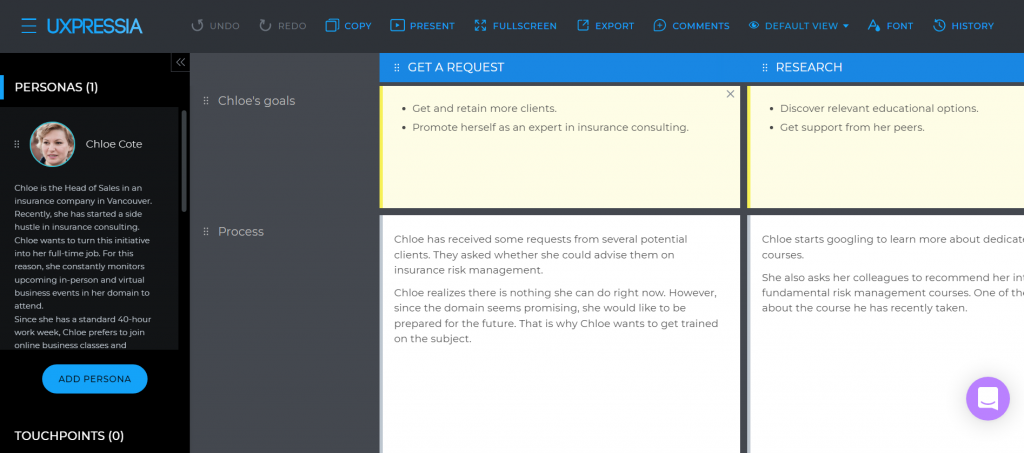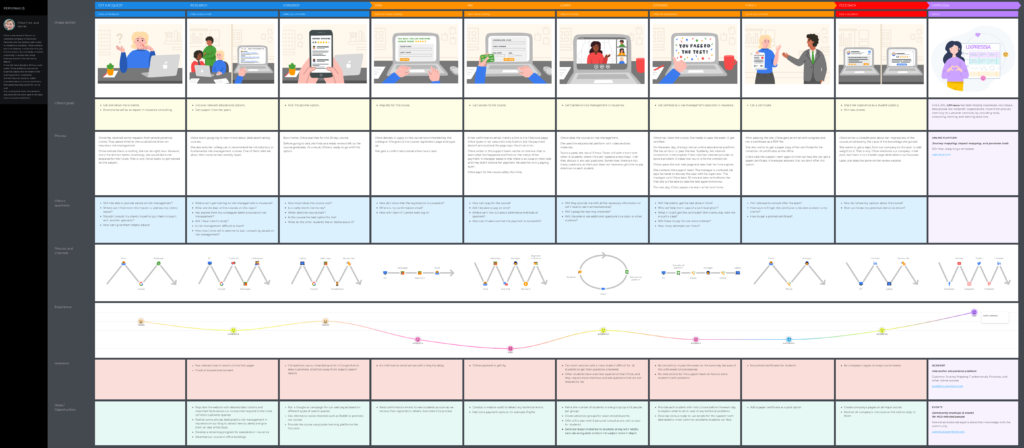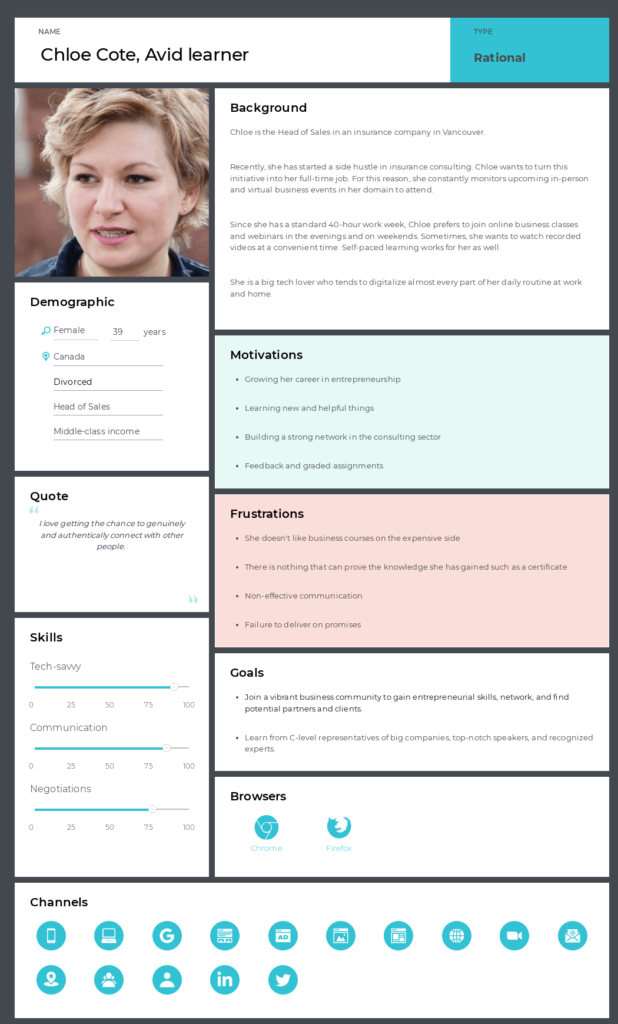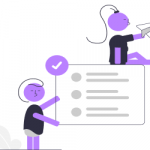The culture of upskilling and reskilling nudges workers and companies to have their finger on the pulse of new technologies and approaches. It also boosts the growth of online courses, training events, and educational webinars.
For instance, over 20 million new learners came to Coursera in 2021.
However, the online education industry is a battlefield. There are many competitors there, including the Ivy League players such as Yale and Harvard.
Educational institutions and businesses employ a variety of methods to attract new students. Some use time-tested marketing techniques, such as discount coupons. Others go further to in-depth analysis to reveal student needs, expectations, goals, and jobs to be done. The latter use student customer personas and journey mapping as a reliable method to analyze their educational programs in terms of learners' demands.
Both personas and maps are based on the data obtained from customer surveys, interviews, and open market research. It turns mapping into a super helpful tool for finding new business opportunities and better understanding your target audience.
If you want to apply this approach and create a student customer journey map for your business, follow these instructions.
Contents
- 1 Step 1: Identify student personas
- 2 Step 2: Determine where a student journey begins and ends
- 3 Step 3: Describe the details of a student journey
- 4 Step 4: Let the feelings flow
- 5 Step 5: Put the insights into action
- 6 Step 6: Get back with new ideas
- 7 A ready-to-go student customer journey map template
Step 1: Identify student personas
You can’t start creating a customer journey map for every student on the planet. Primarily, determine who your target audience covers. Break these people into groups according to their behavior, interests, goals, etc. Here are your personas.
Come up with a name for each persona you describe. Additionally, you can use fictional photos to bring your personas to life. It enables you to think of your customer segments as real people (they really are).
Now add all the information that makes each persona stand out from the crowd: skills, backgrounds, frustrations, motivations, etc. Use your analytics and stats to get it right.
Besides, you can turn to discoveries from education-related research. For instance, the Pearson and The Harris Poll survey describes five types of learners ages 14-40:
- Traditional (25%);
- Hobby (24%);
- Career (19%);
- Reluctant (17%);
- Skeptical (15%).
Step 2: Determine where a student journey begins and ends
Now, you can think about the scope of a journey your personas take. It is up to you to build an end-to-end journey or map out just some part of it, such as the learning process.
Say the first option works best for you, then you need to break down the journey(s) stage by stage.
As a quick point, you can create several maps for different personas. It will get you a deeper understanding of your target groups.
Here is how the sequence of stages of a student customer journey map might look like:
- Awareness;
- Research;
- Consideration;
- Registration;
- Paying;
- Learning;
- Assessment;
- Graduation;
- Feedback.
However, the final number of stages your student customer journey map includes will depend on your case.
Step 3: Describe the details of a student journey
Finally, it is about time to add more details to each stage of your map.
Here are some map sections to be included:
- Persona’s goals—what a student persona wants to achieve. Being on the same page with your customers helps you adjust your offerings and improve communication. For example, your students might need PayPal as a payment option when they pay for a course or want to message you via Live Chat when they are at the consideration stage.
Pro tip: Think of questions your students may have during the journey. It enables you to pinpoint their goals and intentions.

- Processes—what the persona does to reach their goals. Describe how they act at each stage of their journey. For example, you can detail how a student pays for a course via a credit card or searches for feedback from other students on the web.
- Channels—how a student communicates with you. This part of your map details the medium student personas use to interact with your institution (e.g., via browser, email, phone). Analyzing channels also helps you detect touchpoints—all occasions when the interactions between your students and institution happen. For example, they visit your website, apply for your course via the web form, ask a question via email, etc.
- Problems—what obstacles a student encounters through the journey. At the research stage, your students may need more information on your educational programs, or they may want more personal consultations with a tutor during the learning process. Map it out to reveal all points causing problems!
- Ideas and opportunities—what you can do to improve the student experience. This section on the map is crucial for your action plans and prioritizing. It includes the solutions to problems you have detected earlier. By the way, it is the best moment to invite your teammates to join the mapping initiative and work on a problem together during ideation workshops.
Step 4: Let the feelings flow
When you believe your students are rational people, you are wrong. Our emotions influence decision-making processes because we are humans, after all. And you cannot lose sight of it when mapping.
For this reason, it is also a great idea to include an experience graph to your student customer journey map.
How can you benefit from depicting customer emotions?
First, it gets you a better understanding of how your personas feel at different stages. Disappointed people tend not to show brand loyalty or convert into your regular customers. So, you need to find and reveal anything that upsets or angers them.
Second, treating them as real people helps you put yourself into your student’s shoes and understand how you can improve their experience with your institution.
Third, an experience graph is more visible than the conversion rate or the number of applicants. Not all your colleagues grasp the language of statistics and metrics at a glance. With the emoticon graph, it will be easier for your staff to perceive your students' problems and needs.
Step 5: Put the insights into action
When your journey is finished, it’s about time to act on the map! At the end of the day, you didn't make it out of curiosity, did you?
Discuss all discoveries with your team during a student customer journey map presentation. It helps prioritize what you need to do first and develop an action plan.
Step 6: Get back with new ideas
For journey maps to be helpful for your business, they should keep updated. That is why it is a great idea to revise them regularly.
There are many occasions when it makes sense to do it:
- kicking off a new course;
- expanding your business geographically;
- having many complaints about your offerings;
- testing some hypotheses to improve customer experience;
- changing something in your processes: adding new payment options, creating a page on a social platform that is gaining momentum, etc.
Updating your map can be a personal or a teamwork initiative. The thing to keep in mind is to include mapping in your regular marketing toolkit. Otherwise, it could all come down to a waste of time.
A ready-to-go student customer journey map template
Let’s turn all this theory into practice!
Since mapping is a fascinating yet quite complicated activity, you need something to inspire and guide you. For example, here is a ready-to-use template:

It embraces the experience of Chloe Cote, a fictional head of sales at an insurance company who wants to grow her consulting business. For this reason, she searches for suitable training options for online business courses.
Take a look at her end-to-end journey from the Awareness to the Feedback stage.
Grab a free template to adjust and use at your educational institution!
P.S. Do you want to learn the journey of a real online student? Check out our blog post about transitioning to CX, or give a use case for creating a student journey map a look.






